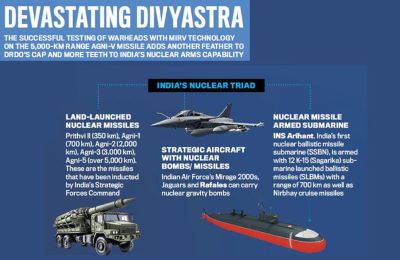Context
India's recent test of the Agni V ballistic missile equipped with multiple independently targetable re-entry vehicle (MIRV) technology marks a significant milestone in its defense capabilities. Prime Minister Narendra Modi announced the success of the test, positioning India among a select group of nations possessing this advanced technology. MIRVs allow a single missile to deliver multiple nuclear warheads to different targets, amplifying the missile's effectiveness and strategic flexibility. This achievement underscores India's growing technological prowess and its commitment to maintaining a credible deterrence posture in the face of evolving regional security dynamics.
Significance of MIRVs
MIRVs represent a formidable advancement in missile technology due to their ability to deploy multiple warheads from a single missile platform. Originating in the United States in the 1970s with deployments like the Minuteman III and Poseidon missiles, MIRVs quickly became integral to the nuclear arsenals of major powers. The Soviet Union followed suit, developing its own MIRV technology, leading to a strategic arms race during the Cold War era. The capability to deliver multiple warheads with precision vastly increases the destructive potential of ballistic missiles, allowing for more efficient targeting of enemy assets.
Furthermore, MIRVs serve as force multipliers, enhancing the efficiency of missile delivery systems. By enabling a single missile to strike multiple targets, MIRVs offer cost-effective solutions for military planners, particularly in the realm of submarine-launched ballistic missiles (SLBMs). The ability to saturate and penetrate ballistic missile defenses adds another layer of strategic advantage, making MIRVs a crucial component of modern nuclear deterrence strategies.
Countries with MIRV Technology
Several nations have developed and deployed MIRV technology, with the United States and the Soviet Union leading the initial advancements during the Cold War. The U.K. and France also possess MIRV capabilities, albeit to a lesser extent. China has emerged as a formidable player in the realm of MIRV technology, with its DF-5B ICBMs equipped with multiple warheads. China's rapid expansion and modernization of its nuclear arsenal underscore the strategic significance of MIRVs in contemporary military doctrines.
Additionally, Russia continues to develop advanced MIRV systems, with some missiles potentially capable of carrying up to 16 warheads. The proliferation of MIRV technology among nuclear-armed states highlights its enduring relevance in maintaining strategic parity and deterring potential adversaries. As demonstrated by India's recent test, the possession of MIRVs signifies a nation's technological sophistication and its capacity to safeguard national security interests in an increasingly complex geopolitical landscape.
Mission Divyastra Test
India's successful test of the Agni V missile with MIRV technology, conducted under 'Mission Divyastra,' represents a significant leap in its defense capabilities. The test, announced by Prime Minister Narendra Modi, was carried out by the Defence Research and Development Organisation (DRDO) from Dr A.P.J. Abdul Kalam Island in Odisha. Various telemetry and radar stations monitored the test, ensuring the successful tracking and monitoring of multiple re-entry vehicles.
The MIRV system tested by India incorporates indigenous avionics systems and high-precision sensor packages to ensure the accurate delivery of re-entry vehicles to their designated targets. This achievement underscores India's growing self-reliance in defense technology and its ability to develop sophisticated missile systems tailored to its strategic requirements. Moreover, the significant contribution of women to the project highlights the inclusive nature of India's defense research and development initiatives.
Implications and Future Outlook
India's successful test of MIRV technology holds profound implications for regional security dynamics, particularly in the context of its strategic competition with China and Pakistan. The development of MIRV-equipped missiles enhances India's deterrent capabilities by increasing the redundancy and flexibility of its nuclear arsenal. Moreover, MIRVs offer a potent means of overcoming sophisticated ballistic missile defenses, ensuring the credibility of India's deterrence posture.
Looking ahead, India's continued investment in missile technology and defense capabilities will likely shape the strategic calculus of regional actors. The reactions from China and Pakistan to India's MIRV test will be closely watched, as they could influence the dynamics of the longstanding triangular contest in South Asia. As India progresses towards serial production of MIRV-equipped missiles, it will be crucial to navigate the evolving strategic landscape while upholding principles of strategic stability and arms control.
Conclusion
In conclusion, India's successful test of the Agni V missile with MIRV technology marks a significant milestone in its quest for technological self-reliance and strategic deterrence. MIRVs represent a potent force multiplier in modern warfare, enabling nations to enhance the effectiveness and flexibility of their nuclear arsenals. With India joining the ranks of MIRV-capable nations, the strategic calculus of South Asia is poised for further evolution. As India progresses towards serial production of MIRV-equipped missiles, it must navigate the complexities of regional geopolitics while upholding principles of strategic stability and nuclear restraint.
|
Probable Questions for UPSC Mains Exam
|
Source – The Hindu







